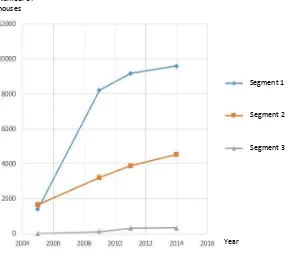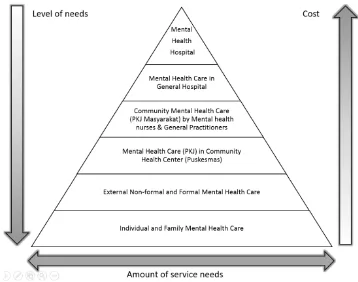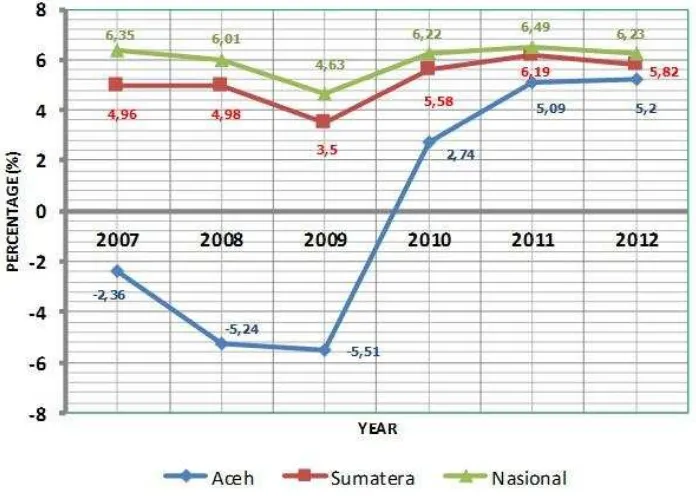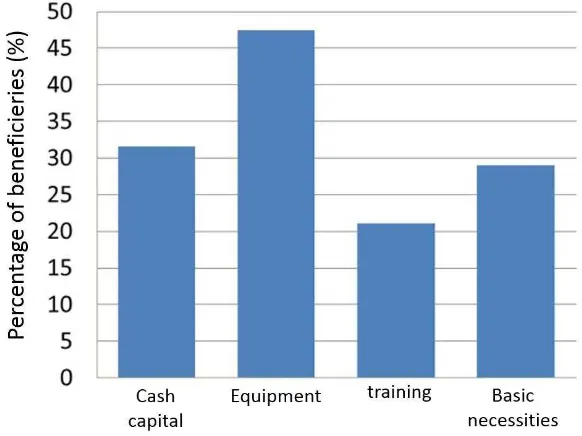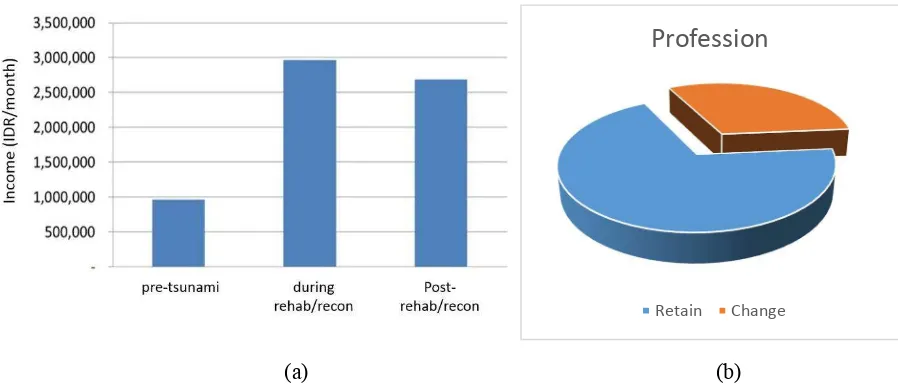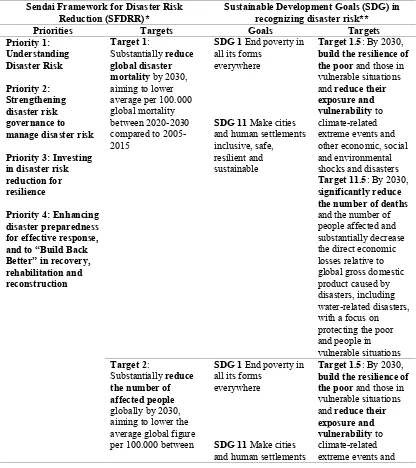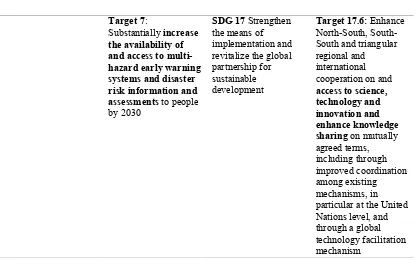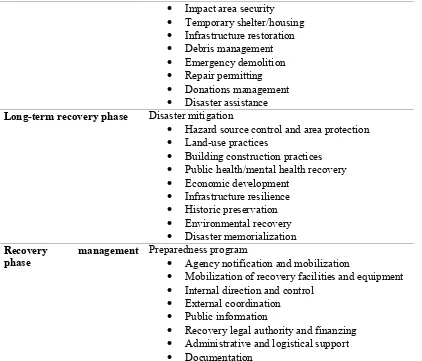Vol. 1, No. 1 (2017): International Journal of Disaster Management - 20
Linking global context of sustainable recovery with a
local context post-tsunami recovery at Banda Aceh city,
Indonesia
Ella Meilianda
1,2,*, Safrida
1,3, Yulia Direzkia
41,* Tsunami and Disaster Mitigation Research Center (TDMRC), Syiah Kuala University, Jl.
Prof. Dr. Ibrahim Hasan, Gampong Pie, Banda Aceh, 23233, Indonesia
2Civil Engineering Department, Engineering Faculty, Syiah Kuala University, Banda Aceh,
23111, Indonesia
3Agriculture Faculty, Syiah Kuala University, Banda Aceh, 23111, Indonesia 4Aceh Mental Health Hospital, Banda Aceh, 23126, Indonesia
*e-mail: ella.meilianda@tdmrc.org
Abstract. The present study examines the recovery progress that has been achieved so far a decade after the tsunami disaster occurred in Banda Aceh city of Indonesia. Assessment of the recovery progress for several activities at the local context associated with the long-term disaster recovery phase include the hazard source control and area protection, land-use practices, mental health recovery, and economic development were conducted to identify windows of opportunities in different sectors to build back better. The findings subsequently situated within the framework of global context, by setting up a global framework linking the common targets between the Sendai Framework for Disaster Risk Reduction (SFDRR) and the Sustainable Development Goal (SDG). Among investigated sectors, the hazard source control, area protection and land-use practices seemed to miss the opportunity of changing the coastal areas to become more resilient to tsunami disaster, due to unsynchronized city masterplan with housing development towards the coastline. While this practice rather discouraging for promoting the idea of ‘build back better’, the other sectors such as community economic revitalization and mental health programs were rather successful in seizing the opportunities at different levels. It requires high commitment from different actors during the recovery to identify and grab the opportunities at the earliest phase of the recovery and to be able to coordinate and formulate the appropriate recovery programs that linked to the targets for sustainable development in the global context.
Keywords:recovery, windows of opportunities, sustainable development, tsunami, Banda Aceh
1.
Introduction
In a place prone to disaster, the population is vulnerable to the potential hazard recurrence. The level of vulnerability should be reduced to minimum in order to reduce risks in every aspects of living condition including physical, economics, social or environmental. This means, the post-disaster situation must be improved, a lot better than they were before, otherwise, it would create the same level of vulnerability once a disaster should occur in the future (Lindell et al, 2006, Smith and Wenger, 2006). On the other hand, disasters provide windows of opportunities for change in various dimensions (Birkmann, 2008) and may be seen in any stages of post-disaster recovery that should be recognized and seized to ensure sustainable development (Brundiers, 2015). The recovery, rehabilitation and reconstruction phase, which needs to be prepared ahead of a disaster, is a critical opportunity to build back better, including through integrating disaster risk reduction into development measures, making nations and communities resilient to disasters (UNISDR, 2015). In the case of post-tsunami 2004 in Aceh of Indonesia, the term ‘build back better’ was widely used. It meant vastly different things to different actors including to the government, disaster management agencies, development donors and agencies, humanitarian agencies and local communities, through a wide range of interventions (Fan, 2013).
Vol. 1, No. 1 (2017): International Journal of Disaster Management - 21 the context of post-disaster recovery within the last decade (Brundiers, 2016; Fan, 2015; Birkmann, 2008, Wiek et al, 2010). They supposedly linked to one another in providing the framework encapsulating the efforts to create resilient recovery which is potential for sustainable development.
The term resilience has recently renowned in post-disaster recovery realm as an ultimate metamorphose from the emergency response, rehabilitation and reconstruction, to the long-term post-disaster recovery. The careful and well-coordinated plan and action of long-term recovery would be potentially earning resilience in a disaster-affected communities, which in turn, would warranty the sustainable development (GFDRR, 2013). A careful investigation should be conducted to identify changing situations from before the disaster event that would lead to a ‘positive inertia’ towards sustainability in development program (Brundiers, 2015, Birkmann, 2008), and linking them to the actual political action and integrate it with the development program (GFDRR, 2013). For instance, institutions not engaged in the past, to become involved at present, or better yet to open new institutions to develop and become engaged during the recovery process (van Eijndhoven et al. 2001a).
In an earlier study, the devastated coastal city of Banda Aceh, Indonesia by the Indian Ocean tsunami of 2004 exemplifies a case in which considered by many as a rare opportunity that it brought the 30-year conflict between local separatist rebels and central government to an end and began the process of peace building. The present study examines the recovery progress that has been achieved so far post-tsunami in Banda Aceh, more than a decade after the 2004 Indian Ocean stricken Banda Aceh city of Indonesia. This analytical investigation in local context is subsequently situated within the framework of global context, by setting up a global framework linking the common targets between the Sendai Framework for Disaster Risk Reduction (SFDRR) and the Sustainable Development Goal (SDG). The idea is that it started with identifying progress made in specific sectors in local context, to recognize any changes made compared to the pre-tsunami’s situations, and whether those changes were taken as windows of opportunities that seized to resilient recovery for sustainable development.
2.
Data and Methodology
The Indian Ocean tsunami disaster occurred on 26 December 2004 has devastated many coastal cities in the surrounding Indian Ocean. While the immense destruction felt around the world, Banda Aceh city at the northern tip of Sumatra Island of Indonesia was one among the most devastated surrounding coastal cities. Out of a total population of 250,000 people, half of the total amount of lives were lost, and another 90,000 were missing. The provincial government and municipality were paralyzed for several of months.
From the scale of devastation to the recovery process after more than a decade, the resourceful information about the progress of recovery and how the recovery process was carried out were gained from several Focused Group Discussions (FGDs) conducted for in this study. There were 5 sessions of FGDs were organized throughout 2014, each invited no less than 80 participants representing different stakeholders including community members, school pupils, teachers and school principals, journalist, businessmen, government officers from various sectors, and other stakeholders.
Vol. 1, No. 1 (2017): International Journal of Disaster Management - 22 The nature of the data collection of the present study is intentionally to be qualitative. A serial of Focused Group Discussions (FGDs) were organized to gather the idea of recovery progress from different perspectives from the invited key informants. Each FGD session was dedicated to discuss what kind of activities involved during the recovery phases (see Table 2) during the past decade post-tsunami in Banda Aceh, and how much they have been progressing. The excerpts of the discussion were subsequently organized into a matrix cross-cutting those activities identified to have windows of opportunities and linked them with the potential sustainability in a global context. For time constraint and practical reasons, not all aspects in life with all their associated activities during the recovery phases were challenged and discussed during the FGDs.
3.
Identifying windows of opportunities in a local-context post-tsunami recovery
Despite a lot of information, issues, and data were found to be relevant and interesting emerged during each discussions, the present study only selects those activities which are potential to create windows of opportunities and thus subsequently analyzed whether they were seized or missed, and to learn their progress from there on after ten years. Several activities associated with the long-term disaster recovery in the case of Banda Aceh city include the hazard source control and area protection, land-use practices, mental health recovery, and economic development were qualitatively assessed.
3.1. Hazard source control, area protection and land-use practices
The tsunami disaster occurred on 26 December 2004 has caused immense destruction on the coastal areas of Banda Aceh, both in terms of its natural condition as well as its functionality for the local inhabitants. The phase of short-term recovery in Aceh has formally started since the establishment of the Agency for the Rehabilitation and Reconstruction of Aceh and Nias (BRR NAD-Nias) has been established and active since 2005 (through an Act of Law No. 2/2005).
Figure 1. Study location at Banda Aceh Coastal Area
Segmen 2
Segmen 1
Vol. 1, No. 1 (2017): International Journal of Disaster Management - 23 Among the preliminary activities conducted under its coordination was the rehabilitation and reconstruction of housing and infrastructure, particularly at the capital city Banda Aceh. In the early few years, based on the needs to quickly restore life basic needs as well as the functionality of infrastructure, many donors both from national and foreign countries were coming to help Banda Aceh by large-scale contribution to the rehabilitation and reconstruction of the housings and roads for the affected inhabitants. At the time, there was no explicit regulations nor does any concrete plan by the government which seem to have play important role in guiding and controlling the process, and also lack of coordination. As a result, only within four years after the tsunami in 2009, the newly built housing areas tend to be expanding towards the coastline (see Fig. 1 and 2).
Figure 2. Growth of new housing areas along the coast of Banda Aceh in a decade after the tsunami disaster of December 2004 (see also Figure 1 for segments information). The renewed masterplan of Banda Aceh city was regulated by Law in Qanun No. 4 year 2009 enacted on 7th December 2009. The legal regulation already includes disaster-based land-use policy (Chapter 1 Article 1 section 5) by which the disaster-prone areas defined as the areas prone to tides, tsunamis and floods. This includes the coastal villages where the tsunami risk is the highest, which areas appear in blue color in Fig. 1. The increasing speed of housing growth occurred particularly during and towards the end of the rehabilitation and reconstruction phase in 2009. While the land-use had finally been regulated since, nevertheless, the implementation of regulation seem to be rather challenging. The main challenges on the implementation are the refusal of the land owners to be relocated further inland, and/or the lack of control on developers to prevent housing expansion near the coastline. Figure 2 shows the growth of housing which growth remains to be increasing, but with slower rate from 2009 till 2014, albeit the new masterplan had been enacted since 2009 (Fig. 2). This suggests that although window of opportunity might be seen (e.g. by the effort of renewing the city masterplan), but since it was enacted rather too late, it missed the opportunity to change from the pre-tsunami’s condition, thus, prevent to build the coastal area better. Another factor contributed to this missing opportunity was the lack of coordination among important actors in making decision on the permit to build houses very near to the high risk coastal areas.
Year Number of
houses
Segment 1
Segment 2
Vol. 1, No. 1 (2017): International Journal of Disaster Management - 24
3.2. Mental Health Recovery
Most of the survivors from the tsunami disaster on December 2004 left with traumatic conditions in different levels during the early phase post-tsunami recovery. During the early phase of recovery, several trauma healing programs were rather sporadically organized using various methods introduced by several foreign assistance to help the traumatized tsunami victims to recover. But the most serious psychological condition which may not detectable much earlier is actually the Post-Traumatic Stress Disorder (PTSD). It was learned from this study that after more than a decade since the tsunami disaster, the manifestation of the undetectable or untreated mental conditions were emerged and transformed into various mental illnesses in the future. Currently, the access to mental health services has been relatively good, since the local government has established a so-called “Aceh Model” mental health care system since the early phase of tsunami recovery (Figure 3). Although it might have been late for the early-treatment of the PTSD, nevertheless, with the current better access to mental health services, better coordination among health sectors down to the community level, the formulated interventions can be readily available for those in need.
Figure 3. “Aceh Model” System of Mental Health Care in Aceh Province post-tsunami disaster 2004
Vol. 1, No. 1 (2017): International Journal of Disaster Management - 25 Affair, committed to build the capacity both mental health institution, as well as the human resources involved. This includes establishing consensus for the role of Community Health Center (Puskesmas) as the backbone for the mental health care at the community level, which is integrated in the “Aceh Model” Mental Health Care System. Up till present, the Aceh Model has become the national reference to be replicated to the other provinces in Indonesia.
3.3. Tsunami-affected communities’ Economic Revitalization
Herein, the analysis of economic revitalization of the community whose members were affected by the tsunami 2004 are discussed separately from the macro-economic to the micro-economic point of views. In the macro-economic point of view, the Regional Gross Domestic Product (RGDP) experienced contraction (negative growth) during the early phase of the recovery (before 2009; Fig. 4). The declining growth was affected by the decreasing production of oil and gas. It is well-known that Aceh’s economic structure was dominated by oil and gas subsector, that the change rate of contribution from this sector will eventually influences the RGDP of Aceh entirely. On the other hand, even though the overall recovered growth percentage remain to be under the national economic growth, even also under the entire Sumatra’s, the growth sentiment tended to be positive since 2010 (Fig. 4). This could happen because the global oil and gas price were improving and so was the non-oil/gas significant contribution, particularly the agriculture and commerce sectors. Part of the increasing percentage in agriculture sector was coming from the recovered function of the coastal land for agricultural areas, while another part was contributed from the rehabilitated commercial trades, thanks to the worldwide post-disaster recovery assistance during the period.
Figure 4. Comparison of economic growth between Aceh, Sumatera Island and National period 2007 – 2012 (source: Bureau of Statistic (BPS), 2013
Vol. 1, No. 1 (2017): International Journal of Disaster Management - 26 The tsunami survivors who live along the coastal areas near Banda aceh are mostly considered as the lower-middle income society. Most of them profess as fishermen, farmers, home-based industry such as conventional fish processing, traditional foods and sweets and tailors. Only a limited number of people work as governmental officers. During the rehabilitation and reconstruction phase (2005 – 2009) large number of aids and assistants delivered to the tsunami-affected coastal communities, either from national and foreign counterparts. The aids and assistance came in various forms, both material and non-material. Figure 5 shows the proportion of the type of aids and assistance given during the entire period.
Figure 5. Proportion of different types of aids from donors for the tsunami-affected communities near Banda Aceh
As seen in Figure 5, the highest percentage of aid type is the equipment, which meant to help the small-scale businesses operational and productive. The second largest ones were the cash capital for starting-up the small businesses and followed by the basic necessities distribution, and the least amount of training for starting up small businesses were also contributed. During this early period of recovery, the distribution of aids were mostly coordinated directly
with the local village leaders (Keuchik), with minimal monitoring and evaluation from third
Vol. 1, No. 1 (2017): International Journal of Disaster Management - 27
(a) (b)
Figure 6. (a) Changing amount of income rates from pre-tsunami, during the short-term recovery phase and the subsequent long-term recovery phase. (b) Proportion of community
members who have their profession retained or changes post-tsunami
Apart from the cash for work, there were also many other temporary jobs that needed to be filled rather quickly offered by international agencies and NGOs, from lower to higher rank of position in the development workforce. Some people took this as a window of opportunity to improve their economic condition, even if it takes a complete change of profession, such as from a farmer to a driver, or a construction worker. Nevertheless, there are still many community members chose to retain to their old profession. Figure 6 reveals the figure of the comparison of income rates for different periods and profession condition of the coastal village community members near Banda Aceh. On the other hand, not all community members were well-equipped or well-informed with sort of exit strategy by the time the highly-paid job position were no longer secured. This percentage of workforce ended up unemployed as soon as the rehab/recon phase came to an end. Another reason of being unemployed was their reluctance of working with a lower-paid salary.
After the rehab-recon was over, during the subsequent recovery phase, although the NGOs and foreign agencies were repatriated, the Indonesian government, both national and local continued to foster the tsunami-affected community economic revitalization through several of their offices programs; including by the Office of Industry and Commerce, Office of Marine and Fisheries, and Office of Social. While during the rehab/recon period the type of aids and assistance were mostly in the form of materials, during the subsequent period, the aids and assistance were more focused on non-material contributions, such as training or cash capital for starting up small businesses. The phase where the government took over in revitalizing economic condition of the community was actually shows a rather promising prospect, even until now. The main factor which perhaps guarantee the sustainability of the cash capital provided by the local government are because for most of the people, it can be an alternative or solution after the employment with the international agencies has terminated. Another factor is that the monitoring and evaluation were functioning well conducted by the corresponding offices.
4.
Linking global context with local context to examine post-disaster recovery
progress
Among 4 (four) priorities determined in the Sendai Framework for Disaster Risk Reduction (SFDRR) 2015 - 2030, Priority 4 specifically highlights the necessity to enhance disaster
Profession
Vol. 1, No. 1 (2017): International Journal of Disaster Management - 28 preparedness for effective response and to “Build Back Better” in recovery, rehabilitation and reconstruction (UNISDR, 2015). The formal document describes that the steady growth of disaster risk is expected for all countries at risk. On the other hand, development measures can be directly framed into the Sustainable Development Goals (SDGs), which calls for a universal action to end poverty, protect the planet and ensure that all people enjoy peace and prosperity (UN, 2015). SDGs works in the spirit of partnership and pragmatism to make the right choices to improve life in a sustainable way for future generations.
Both SFDRR and SDGs have set their own priorities or goals and specific targets towards year 2030. Among all targets, there are several ones identified by SFDRR and SDGs which are in common or relevant to one another that are relatable to the activities commonly recognize Disaster Risk Reduction agenda which encapsulating the phases of post-disaster recovery. Table 1 summarized the common targets between SFDRR and SDGs to recognize Disaster Risk Reduction in the Post-2015 Development Agenda. The complete sets of targets of SFDRR can be found in UNISDR (2015) and of SDGs can be found in UN (2015).
Table 1. The common targets between SFDRR and SDGs in recognizing DRR Sendai Framework for Disaster Risk
Reduction (SFDRR)* Sustainable Development Goals (SDG) in recognizing disaster risk**
Priorities Targets Goals Targets
Vol. 1, No. 1 (2017): International Journal of Disaster Management - 29 2020-2030 compared
to 2005-2015 inclusive, safe, resilient and sustainable
SDG 9 Build resilient infrastructure, promote facilities that are child, disability and gender
Vol. 1, No. 1 (2017): International Journal of Disaster Management - 31
In the local context, disaster recovery comprises phases and encompasses multiple sectors, which activities implemented both sequentially, overlapping or simultaneously. In disaster management cycle, disaster recovery in general divided into four phases, with each phase proposed in different terms, nevertheless have similar definitions. For instance, the first phase is disaster assessment (Lindell, 2013) or so-called ‘response phase’ in FEMA (2011), within which emergency measures and physical impacts are identified immediately after a disaster. The second phase is the short-term recovery (Lindell, 2013) which is corresponding to rehabilitation and reconstruction phase (FEMA, 2011) focuses on the immediate tasks of securing the impact area, housing victims, and establishing conditions under which households and businesses can begin the process of recovery. The third phase is the long-term reconstruction which is actually another term of disaster mitigation in disaster management, within which reconstruction of the disaster impact area and management of disaster’s psychological, demographic, economic, and political impacts are executed. Last but not least, the fourth phase is the recovery management which monitors the performance of the disaster assessment, short-term recovery, and long-term reconstruction functions. It also reassures that they are coordinated and provides the resources needed to accomplish them (Lindell, 2013), in other words, it is a phase of disaster preparedness (FEMA, 2011).
A summary of activities commonly undertaken during individual phases of disaster recovery are adopted as described in Table 2 (Lindell, 2013; FEMA, 2011). Its goal is to restore normal community activities that were disrupted by disaster impacts through a process involving both activities that were planned before disaster impact and those that were improvised after disaster impact.
Table 2. Summary of phases of disaster recovery (modified from Lindell, 2013; FEMA, 2011)
Disaster Recovery Phases Activities
Response phase Disaster assessment
Rapid assessment
Preliminary damage assessment
Site assessment
Victims’ needs assessments
“Lessons learned”
Vol. 1, No. 1 (2017): International Journal of Disaster Management - 32
Impact area security
Temporary shelter/housing
Infrastructure restoration
Debris management
Emergency demolition
Repair permitting
Donations management
Disaster assistance
Long-term recovery phase Disaster mitigation
Hazard source control and area protection
Land-use practices
Building construction practices
Public health/mental health recovery
Economic development
Infrastructure resilience
Historic preservation
Environmental recovery
Disaster memorialization
Recovery management
phase Preparedness program Agency notification and mobilization
Mobilization of recovery facilities and equipment
Internal direction and control
External coordination
Public information
Recovery legal authority and finanzing
Administrative and logistical support
Documentation
In this study, the common targets of SFDRR and SDGs are used as the global framework within which the analysis of the local context for the recovery progress qualitatively obtained from several FGDs in Banda Aceh are nested. The purpose is to examine how much recovery in individual sectors at the local context has been achieved and can contribute towards the targets in a global context. The main focus of interest in this study is the long-term recovery phase within which mitigation measures at the local context were taking into account and analyzed for their foreseeable prospect of sustainable development in global context. Nevertheless, it is notifiable that the conducted assessment was done during the first ten years after the tsunami disaster, which in a term scale might be considered as the early phase of the actual long-term phase of recovery. The synthesis of this framework for the case of Banda Aceh city post-tsunami recovery is provided in the cross-cutting matrix in Table 3.
Table 3 Cross-cutting local context disaster recovery progress with global context sustainable development targets.
Long-term Recovery SFDRR
Targets (see Table 1)
SDGs Targets (see Table 1)
Sectors Recovery Progress
Hazard source control and area protection
National, Provincial & District & Municipality Disaster Risk
Mapping and Disaster Management Plan
Vol. 1, No. 1 (2017): International Journal of Disaster Management - 33 Land-use
practices Decree of BNPB Head No. 4/2013 on Technical Guidelines for Post Disaster Settlement Rehabilitation and Reconstruction
Target 1, 2, 5 Target 1.5,
11.5, 11.b, 13.1
Mental health
recovery Regulation by law in Qanun No. 5/2008 for assigning Counseling and Trauma division under Department of Health
Target 2, 5 Target 1.5,
Target 11.b
Regulation by law in Qanun for Health 2010 which includes article of mental health is included in several of its articles
Since 2013 mental health has been assigned as one of the Provincial Budgeting's nomenclature Economic
development Micro-finance institution for start-up and small businesses were provided by third party and managed by local government
Target 3 Target 11.5
Changing professions among farmers and fishermen to
temporary position but high salary Economic structure experiences shifts where primary (agriculture) and secondary (industry) sectors, replaced by teriary sectors (commerce, hotel & restaurants, etc.)
GRDP experiences positive growth corresponds to improvement of oil & gas price and contribution from non-oil/gas sectors (agriculture & commerce)
5.
Conclusions
Vol. 1, No. 1 (2017): International Journal of Disaster Management - 34 to become more resilient to tsunami disaster, due to unsynchronized city masterplan with housing development towards the coastline. While this practice rather discouraging for promoting the idea of ‘build back better’, the other sectors such as community economic revitalization and mental health programs were rather successful in seizing the opportunities at different level. To conclude, it requires high commitment from different actors during the recovery to identify and grab the opportunities at the earliest phase of the recovery and to be able to coordinate and formulate the appropriate recovery programs that linked to the targets for sustainable development in the global context.
Acknowledgements
Authors wishing to acknowledge all stakeholders invited during the FGDs, students volunteers, many colleagues in each working group of the assessment for their assistance and shared knowledge and expertise during the assessment and FGDs. A special thanks to Prof. Yasuo Tanaka for bringing up the idea of conducting several FGDs for data collection, and Katja Brundiers for introducing the concept of windows of opportunities for sustainable development at the final stage of the assessment which helps to put the assessment into perspective. The assessment of post-tsunami recovery was conducted by TDMRC of Syiah Kuala University in 2014 in commemorating the 10 th year of the Indian Ocean tsunami disaster. We thank Badan Penanggulangan Bencana Aceh (BPBA) and Kobe University forfinancing the assessment of post-tsunami recovery of Banda Aceh City.
Reference
Birkmann, J., Buckle, P., Jaeger, J., Pelling, M., Setiadi, N., Garschagen, M., Fernando, N., Kropp, J. (2008). Extreme events and disasters: a window of opportunity for change? Analysis of organizational, institutional and political changes, formal and informal
responses after mega-disasters. Natural Hazards, 55(3), 637-655.
BPS (2013). Aceh in Number, 2013, BPS Aceh. (In Indonesian).
Brundiers, K. (2015). Do disaster create opportunities for change towards sustainability? Initial
evidence from Aceh, Indonesia, Working Paper Series, 1, January 2015, Resilience
Development Initiative.
Fan, L. (2013). Disaster as opportunity? Building back better in Aceh, Myanmar and Haiti,
HPG Working Paper, November 2013, Humanitarian Policy Group.
FEMA (2011). National Disaster Recovery Framework. Strengthening Disaster Recovery for
the Nation. September 2011, FEMA
GFDRR (2015). Resilient Recovery: An imperative for sustainable development, GFDRR.
Lindell, M.K. (2013) Encyclopedia of natural hazards, Springer
UN, (2015) Transforming our world: the 2030 Agenda for Sustainable Development.
A/RES/70/1. http://www.sustainabledevelopment.un.org
UNISDR, (2015). Sendai Framework for Disaster Risk Reduction 2015 – 2030 (UNISDR/GE/2015 – ICLUX EN5000 1st edition), Geneva, 37 p. Retrieved from
http://www.preventionweb.net/files/44983_sendaiframeworkchart.pdf /
Van Eijndhoven, J., Clark, W.C., Jaeger, J. (2001). The long-term development of global
environmental risk management. The Social Learning Group, Learning to Manage
Global Environmental Risks, 2. The MIT Press, Cambridge.
Wiek, A., Ries, R., Thabrew, L., Brundiers, K., Wickramasinghe, A. (2010). Challenges of
sustainable recovery processes in tsunami affected communities. Disaster Prevention

